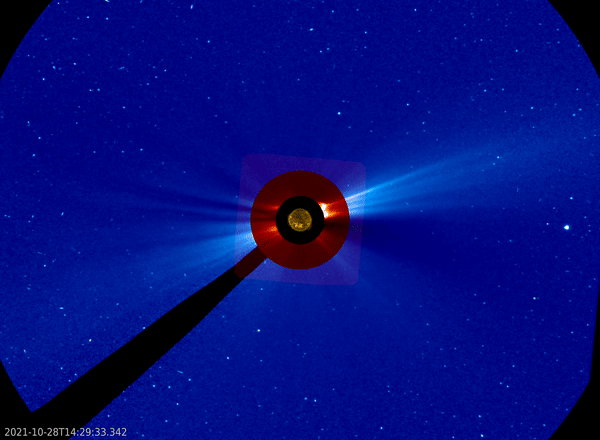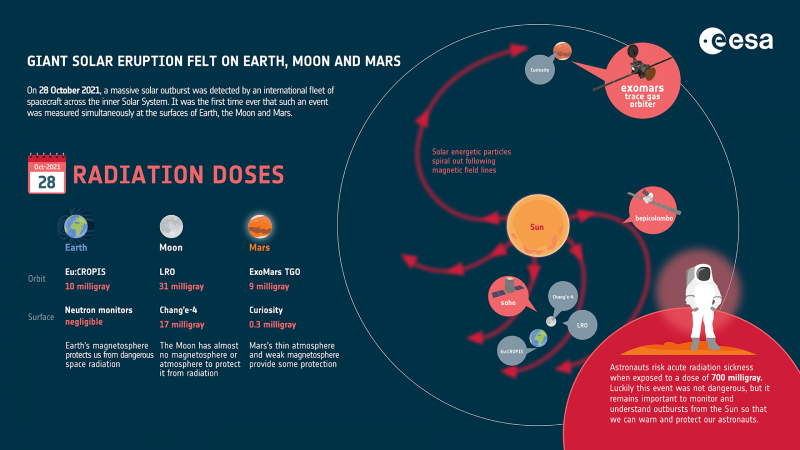
Giant solar eruption October 28, 2021
How safe are humans from solar particles blasted from the sun? A giant solar eruption on October 28, 2021, was a reminder that our home star can blast out particles that might imperil astronauts in Earth-orbit, or beyond. Indeed, the 2021 eruption was so large and widespread that it impacted both the Earth and moon, and our neighboring planet Mars. This is even though Earth and Mars were on opposite sides of the sun at the time and 155 million miles (250 million km) apart. ESA said on August 2, 2023, that it was the first time scientists were able to measure a single solar event of this sort from three planetary bodies. Solar physicists call it a Ground Level Event, or GLE.
Additionally, they said that studying these sorts of events will help solar physicists and space scientists learn how to protect astronauts in space. This particular event – measured from three worlds – was especially helpful in preparing astronauts for solar particle impacts in different environments.
Space missions that recorded this event from Mars’ surface included the European Space Agency’s ExoMars mission, NASA’s Curiosity rover on Mars and Lunar Reconnaissance Orbiter, China’s Chang’e-4 moon lander and Germany’s Eu:CROPIS Earth orbiter.
Researchers studying the 2021 outburst published their peer-reviewed study in the journal Geophysical Research Letters on August 2, 2023.
Rare, energetic solar events
Scientists call the giant solar eruption that happened on October 28, 2021, a rare ground level enhancement. In these rare events, solar particles have enough energy to pass through Earth’s protective magnetic field. For example, the 2021 event was only the 73rd (and most recent) ground level enhancement since records began in the 1940s.
Also, the moon and Mars are smaller worlds. Their iron cores are now inactive and don’t generate magnetic fields. Therefore, solar particles have no trouble reaching the surface of these neighboring worlds. In fact, the particles can interact with the soil to create secondary radiation. Mars, at least, has a thin atmosphere that can keep less-energetic solar particles from hitting the surface. Plus, its atmosphere slows down the more energetic particles.
Measuring the impact on astronauts
We hope to send humans to the moon and Mars in the not-too-distant future. Therefore, scientists need to understand how solar particles impacting these worlds can affect astronauts.
Radiation sickness is serious and often fatal. Doses of radiation are measured in a unit of absorption called a milligray. A radiation dose above 700 milligray may cause radiation sickness by destroying bone marrow. Some of the symptoms of radiation sickness include infection and internal bleeding. If an astronaut were to receive 10,000 milligray (10 gray), they’d likely die within two weeks.
Between the Apollo 16 and 17 missions, in August 1972, a giant eruption blasted from the sun. To be sure, the eruption was so energetic that any astronauts on the moon or in transit at the time would have received a possibly lethal amount of radiation.
In contrast, the Lunar Reconnaissance Orbiter’s measurement of the recent 2021 event was a safer 31 milligray. Lead author Jingnan Guo of the University of Science and Technology of China said:
Our calculations of the past ground level enhancement events show that on average one event every 5.5 years may have exceeded the safe dose level on the moon if no radiation protection had been provided. Understanding these events is crucial for future crewed missions to the surface of the moon.
Mars’ protective atmosphere
Even though Mars’ atmosphere may be thin, it still provides protection against solar radiation. For example, in the 2021 event, the ExoMars spacecraft orbiting Mars measured 9 milligray. By comparison, the Curiosity rover on Mars’ surface measured just 0.3 milligray. That’s 30 times more protection from Mars’ atmosphere.

How to stay safe from a giant solar eruption
With enough lead time, astronauts can take protective measures against incoming radiation. For example, the kitchen of the space station has walls that shield against radiation. On the surface of the moon or Mars, astronauts could don special protective clothing or retreat to specially made structures or underground.
Artemis is the mission that will return humans to the moon. Part of the Artemis mission includes a way station called the Gateway. It will include three different suites of instruments to monitor radiation 1,900 miles to 43,500 miles (3,000 to 70,000 km) from the moon.
The first Artemis mission also flew two dummies, one dressed in protective gear and the other without. Scientists are still monitoring the differences experienced by the mannequins.
Colin Wilson, a project scientist for ExoMars’ Trace Gas Orbiter (TGO), summed up:
Space radiation can create a real danger to our exploration throughout the solar system. Measurements of high-level radiation events by robotic missions is critical to prepare for long-duration crewed missions. Thanks to data from missions like ExoMars TGO, we can prepare for how best to protect our human explorers.
Bottom line: A giant solar eruption from 2021 is teaching scientists how to protect future astronauts. The radiation from the 2021 event struck Earth, the moon and Mars simultaneously.
Source: The First Ground Level Enhancement Seen on Three Planetary Surfaces: Earth, Moon, and Mars











